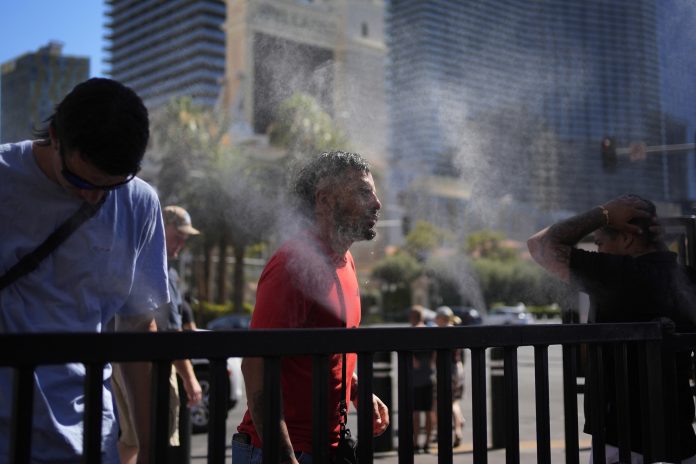Accustomed to high temperatures, Las Vegas residents are now closely monitoring the thermometer as the desert city is set to break a record for the most consecutive days over 115 degrees Fahrenheit (46.1 Celsius) on Wednesday. The ongoing heatwave is expected to continue scorching much of the U.S. into the weekend.
On Tuesday, Las Vegas once again neared the all-time high of 120 F (48.8 C) recorded on Sunday, settling instead for a new daily record of 119 F (48.3 C), surpassing the previous high of 116 F (46.6 C) set in 2021. Forecasters predict the city will likely reach a record fifth consecutive day above 115 F (46.1 C) on Wednesday.
Even by desert standards, this prolonged heatwave in Nevada’s largest city is nearly unprecedented. “This is the most extreme heat wave in the history of record-keeping in Las Vegas since 1937,” said meteorologist John Adair, a veteran of three decades at the National Weather Service office in southern Nevada.
Tuesday’s high temperature tied the record of four consecutive days above 115 F (46.1 C) set in July 2005. Adair mentioned that the record could extend through Friday.
Alyse Sobosan noted this July has been the hottest in her 15 years living in Las Vegas. As a counselor at a charter school on summer break, Sobosan avoids going outside during the day and waits until 9 p.m. or later to walk her dogs. “It’s oppressively hot,” she said. “It’s like you can’t really live your life.”
Health officials have emphasized the dangers of such extreme heat. “Even people of average age who are seemingly healthy can suffer heat illness when it’s so hot it’s hard for your body to cool down,” said Alexis Brignola, an epidemiologist at the Southern Nevada Health District.
The heatwave gripping large parts of the U.S. also led to record daily high temperatures in Oregon, where it is suspected to have caused eight deaths, according to the state medical examiner’s office. More than 142 million people across the U.S. were under heat alerts on Wednesday, especially in Western states. The National Weather Service warned of major-to-extreme heat risk over portions of the East Coast.
An excessive heat warning remained in place Wednesday for the Philadelphia area, northern Delaware, and nearly all of New Jersey. Temperatures were around 90 F (32.2 C) for most of the region, with a heat index potentially reaching 108 F (42.2 C). The warning was set to expire at 8 p.m. Wednesday, though it may be extended.
Dozens of locations across the West tied or broke previous heat records over the weekend and are expected to continue doing so all week, although relief is in sight for some areas.
The heat was blamed for a motorcyclist’s death over the weekend in Death Valley National Park. On Tuesday, tourists in Death Valley queued for photos in front of a giant thermometer reading 120 F (48.9 C). Simon Pell and Lisa Gregory from London stepped out of their air-conditioned RV to experience the midday heat. “I don’t need a thermometer to tell me that it’s hot,” Pell said. “You hear about it in stories and wildlife documentaries. But just for me, I wanted to experience what it would feel like. … It’s an incredible experience.”
Death Valley is known for its extreme environment, with a temperature of 130 F (54.4 C) recorded there in July 2021. Record highs for the date were also hit Tuesday in parts of Oregon and Washington, with Portland reaching 103 F (39.4 C) and Salem and Eugene hitting 105 F (40.5 C).
The Oregon State Medical Examiner’s Office confirmed two new suspected heat-related deaths on Wednesday, bringing the total to eight during the heatwave. The victims included an 83-year-old man in Washington County and a 72-year-old man in Multnomah County. Most of the deceased were men aged 64 and older.
The National Park Service is investigating the third hiker death in recent weeks at the Grand Canyon, where temperatures on some trails can reach 120 F (49 C) in the shade. A 50-year-old man collapsed on Sunday, and bystanders and medical staff were unable to revive him.
Phoenix, which has averaged the hottest temperature ever for the first eight days of July in records dating back to 1885, tied its daily record of 116 F (46.6 C) set in 1958.
This U.S. heatwave coincides with a global temperature record in June, marking the 12th straight month that the world was 1.5 degrees Celsius (2.7 degrees Fahrenheit) warmer than pre-industrial times, according to the European climate service Copernicus. Scientists attribute most of this heat to human-caused climate change from greenhouse gas emissions.
In Las Vegas, hotels and casinos keep visitors cool with massive AC units. However, for homeless residents and others without access to safe environments, officials have set up emergency cooling centers at community centers across southern Nevada. Firefighters in Henderson, Nevada, have deployed “polar pods” to cool people exhibiting symptoms of heat stroke or related emergencies. These devices, first used in Phoenix, can immerse a patient in cold water on the way to a hospital.
Extreme heat in the West has also dried out vegetation, fueling wildfires. A new blaze in Oregon, dubbed the Larch Creek Fire, quickly grew to more than 5 square miles (12 square kilometers) on Tuesday evening, prompting evacuations for remote homes. In California, firefighters were battling at least 19 wildfires, including a 45-square-mile (117-square-kilometer) blaze in Santa Barbara County and a 3.6-square-mile (9.3-square-kilometer) Vista Fire in the Mount Baldy area of the San Bernardino National Forest.
The National Weather Service extended excessive heat warnings across most of the Southwest U.S. through Saturday morning. “It’s not over yet,” said the service in Reno.




